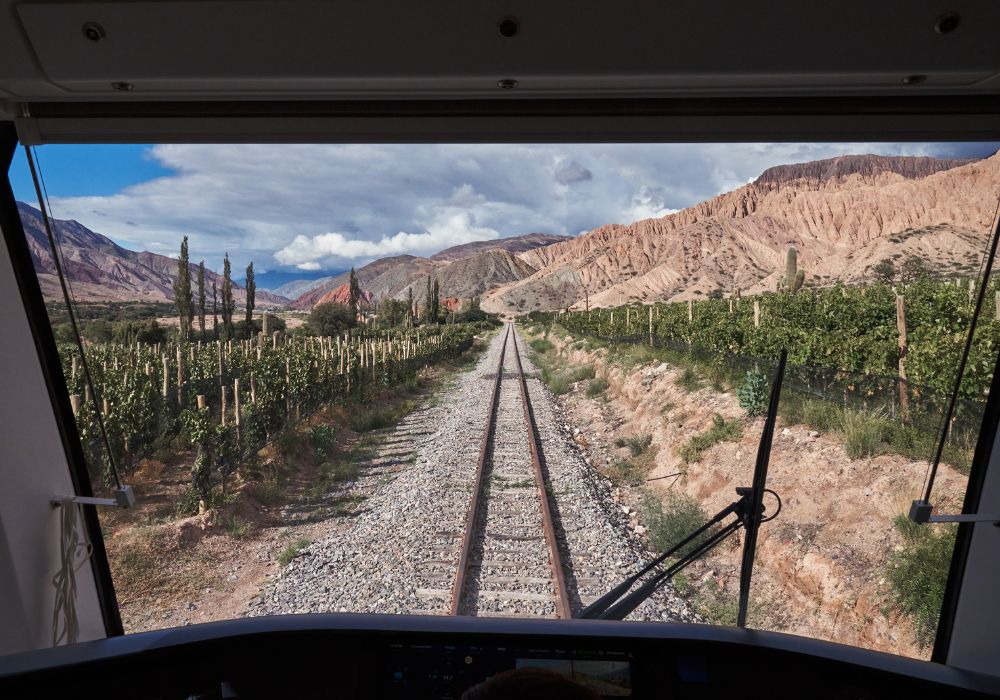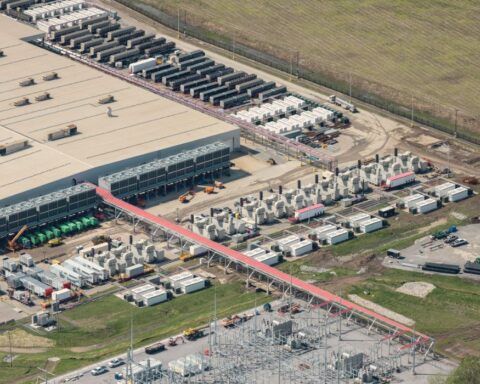It had been 30 years since a train ran through a stretch of Argentina’s Quebrada de Humahuaca.
The mountainous region in the northern province of Jujuy is known for its enchanting, multicoloured rockscape and the chain of settlements that hug the rugged valley. In 1993, a diesel locomotive ceased to operate. But last year, after track upgrades and a concerted effort from local politicians, a gleaming solar-powered battery train made its maiden run. Authorities have gushed about the electric train, describing it as a beacon of green innovation that could bolster one of the most popular tourist destinations in the country.
But zoom out and another picture snaps into view. Engineered by a state-owned Chinese manufacturer, with Chinese-made lithium phosphate batteries charged by a Chinese-built solar farm, the 70-seat train is an example of the kind of power wielded by one of the key drivers of the global energy transition. Soft power to go hand in hand with big, bold power, as China takes a commanding role in the world’s race to get to net-zero before the devastating impacts of climate change hit another level.
China is, for all intents and purposes, fuelling the global green transition right now. The latest flagship renewables report from the International Energy Agency forecasts that China will account for nearly 60% of all renewable capacity installed around the globe from now until 2030. If those projections play out as predicted, China will be home to nearly half the world’s total renewable-power capacity by the end of the decade. In fact, clean energy investment by China nearly equalled the money poured into fossil fuels globally in 2024. The progress is being driven by the “new three” of electric vehicles, batteries and solar, which grew twice as fast as the Chinese economy as a whole and accounted for one-quarter of its GDP growth last year, according to analysis from Carbon Brief. In 2023, China installed most of the world’s new solar capacity, a whopping 58%.

China’s trajectory represents a remarkable pivot in international perception. Saddled with the title of the world’s biggest polluter as its economy boomed at the turn of the century, China is having a green awakening. It has secured strategic resources critical to the green economy, opened new trade routes and inked debt-funded alliances. Although its environmental record at home remains mixed – it has seen its use of coal-fired power drop but is still building more plants within its borders – the momentum is positive. China appears on track to see its emissions peak by 2030. All the while, it has vowed not to build any new coal-fired plants abroad. As Xi Jinping announced in 2021 before the United Nations General Assembly, the country is pledging to “increase support for other developing countries in developing green and low-carbon energy.” With the United States retreating from environmental leadership, the China factor will matter even more to developing economies. Half of China’s solar, wind and EV exports already go to the Global South.
“With the U.S. pulling out of the Paris Agreement, there is a fracturing of trust that is happening,” says Fikayo Akeredolu, a Nigerian climate and energy-transition scholar completing a doctorate at the University of Oxford. China “now looks like the good guy.” The question is, she says, “Are you good because you’re good, or are you good because the other guy is bad?”
From brownouts to ‘small but beautiful’
It’s helpful to consider how China got here. China’s renewable-energy story began almost 25 years ago, in 2001. It had just entered the World Trade Organization and its economy was growing much more quickly as a result. But unlocking trade propelled it at a figurative wall: demand for energy was outpacing supply. Brownouts were a recurring issue. It was already relying on heavy imports of oil and coal, so energy security was a growing problem. “Obviously, energy is key to economic growth,” says Alex Wang, law professor at the University of California, Los Angeles, and co-director of the Emmett Institute on Climate Change and the Environment. Wang’s research focuses on the law and politics of Chinese environmental governance, and he’s written a book, coming out this year, called Chinese Global Environmentalism. China, he notes, was already seeing various environmental limits to its growth.
The year 2007 was momentous because the Intergovernmental Panel on Climate Change further crystalized the impact humans were having on modern climate change – and researchers identified China, producer of ever more goods in a globalized world, as the biggest emitter of greenhouse gases, ahead of the United States. At the same time, renewable-energy technologies, especially solar and wind, were maturing. But the United States was divided on whether to invest in that direction, Wang says. The EV industry in the United States was struggling, and China saw that. One year earlier, in 2006, it had enacted the landmark Renewable Energy Law, which set a framework for it to promote the development of clean energy. “So I think Chinese leaders saw an opportunity to achieve a lot of different goals all at once by really investing heavily on renewable energy,” Wang says. And then a few years later they saw the same opportunity with EVs. “As they are doing all the things that they need to do for very practical reasons, they can also say they are contributing to global climate goals.”

This shift is visible in the controversial Belt and Road Initiative (BRI), China’s massive plan to build a global network of land and maritime infrastructure projects, including ports, highways, railways and fibre optic networks. Since it was launched in 2013 with the goal of greasing access to international markets and boosting connectivity, nearly $1.2 trillion has already been earmarked or spent. Roughly 150 countries have signed on or said they intend to. For some, especially in the Global South, it’s been a welcome injection of cash. But China’s mission has been marred by white elephant projects, such as railway and highway ventures in Kenya and Uganda that are choking governments with debt payments, along with growing environmental and social pushback.
At the same time, of course, the initiative has advanced China’s political interests. In 2022, for example, Nicaragua joined the BRI one month after severing diplomatic ties with Taiwan. More recently, BRI has gone through a rebranding, with an emphasis on green. Authorities now emphasize “small yet smart” and “small but beautiful” investments, such as the solar-powered train in Quebrada de Humahuaca. And while the envelope has shrunk, in 2023 the China Development Bank and the Export–Import Bank of China announced they would each be dispersing US$48 billion for energy-related projects.
Part of the success of these ambitious development goals, no doubt, derives from China’s ability to drive down costs through its manufacturing prowess and lax approach to labour conditions. Solar panels in the United States and Europe cost three times as much as in China, but China’s treatment of workers is notoriously poorer than Western democracies’.
For China, Wang says, it’s not about altruism; it’s about business. He describes the mentality like this: “We are making a lot of stuff that we want to sell; we need places to sell it. And it so happens that lots of countries have these decarbonization targets, so how perfect is that?”
Powering up energy deserts
In some cases, China’s role in decarbonization may even be incidental. Power is the product; renewables are just a better way to get it.
“To talk to someone about the energy transition implies that they have some kind of energy already,” notes Akeredolu, the Nigerian energy expert. Some 600 million Africans did not have access to electricity in 2022, according to the International Energy Agency, most of them in sub-Saharan Africa. In Nigeria, the most populous country in Africa and a major producer of petroleum, roughly 60% of its residents are energy-poor.
“I’m looking at what countries like China are doing to plug that energy gap,” Akeredolu says. And at the moment, it’s a lot. At its 2024 Summit of the Forum on China–Africa Cooperation, the Chinese government earmarked US$51 billion in financial support to Africa over the next three years, including for 30 clean energy projects. Large-scale infrastructure projects, such as hydro dams, require the kind of massive flows of money managed by the Chinese state. But smaller-scale ventures, in particular solar, have been cornered by private Chinese companies, Akeredolu says.

A wave of customization is taking root, spurred by the Nigerian government’s decision to cut petrol subsidies, which were eating up more of the state budget than health, education and infrastructure combined. Now that the government has rolled back subsidies, solar – which had a higher upfront cost – has become more attractive, at least to middle-income earners. “There are a lot of Nigerian companies now that are literally going to China and saying, ‘Hey, listen, you have all these solar PVs, you have all this tech, but it’s too expensive for our consumers – so what can you do?’” Akeredolu says. “‘Can we have some sort of pay-as-you-go model? Instead of a whole solar panel that powers a whole house, can we have something that just powers a television?’” And they are having success, with Nigerian entrepreneurs embarking on fact-finding missions in China to understand their manufacturing processes and how to emulate them at home.
“I would argue that the perception of China right now in the African context around energy or renewables, I think, is very positive,” Akeredolu says.
When it comes to solar, it’s not about aid or even loans, she adds. Chinese firms are simply interested in making money, and they’re employing domestic labour to do so. In fact, Nigerian companies are crucial to the equation, to ensure buy-in from locals. “Actual Nigerians are taking ownership of the conversation and saying, ‘This is what we need, this is how we need it, and this is how we build it.’”
Global South dominance
 China’s influence across the Global South has grown rapidly in recent years. In South America, it has overtaken the United States as the largest trading partner, and it holds the second spot for Latin America as a whole. Countries rich in oil and metals rode the wave of booming markets in China and India, providing the commodities they needed to grow. Brazil, Bolivia and Peru, for example, saw major declines in poverty, according to analysis by the International Monetary Fund, while debt-stricken Argentina dug itself out of a financial hole.
China’s influence across the Global South has grown rapidly in recent years. In South America, it has overtaken the United States as the largest trading partner, and it holds the second spot for Latin America as a whole. Countries rich in oil and metals rode the wave of booming markets in China and India, providing the commodities they needed to grow. Brazil, Bolivia and Peru, for example, saw major declines in poverty, according to analysis by the International Monetary Fund, while debt-stricken Argentina dug itself out of a financial hole.
These last two decades have also seen China stake out a significant presence in the region’s energy grid. Since 2000, the China Development Bank and the Export–Import Bank of China have financed nearly US$10 billion in energy-generation and -distribution projects in Latin America and the Caribbean, according to analysis from Boston University.
Often, the investments are welcomed by countries otherwise strapped for cash. China’s Belt and Road Initiative, for example, funded the high-altitude Cauchari solar farm in Argentina’s Jujuy province that is powering the batteries for the Humahuaca train, and generates electricity for 70% of the province’s inhabitants. The project relied heavily on Chinese involvement, from engineering to solar panels, Huawei technology, cables and other imported equipment.
But there was also pushback. Indigenous communities, environmentalists and local residents across the country have opposed large-scale clean energy projects that displace settlements or come with environmental costs, such as a major dam in the southern province of Santa Cruz. Cauchari also faced resistance for similar reasons. And for all its environmental attributes, the solar-powered battery train has faced considerable opposition from local communities, who criticized insufficient transparency, the displacement of families along the rail line, and the cost of tickets. The emergence of monopolies is another source of concern, as seen in Chile, where state-owned Chinese companies control 57% of the country’s energy distribution.
“China is looking to exert its influence through the economy, either through indirect or direct investment – rather than the sort of military interventions that used to be carried out by the United States in the region,” says Santiago Rosselot, co-author of a 2022 study on Chinese investments in the Southern Cone of South America by the Chilean think tank Fundación Sol. Rosselot questions China’s role in pushing the energy transition forward in the region and argues that its presence is strategic. South America is rich in the critical minerals required for the energy transition: lithium, copper, nickel and rare earth elements. The so-called lithium triangle, an area about the size of California that stretches over parts of Argentina, Chile and Bolivia, accounts for 60% of the world’s lithium reserves.
“The main threat we see is a sort of neo-extractivism,” Rosselot says. “The energy transition is happening, but the same logic is still applying, which is that Latin America is providing the raw materials for the industry to happen in another place.”
Although the price of lithium has dropped because of concerns over a glut in the market and fears of a slower uptake of EVs, mining giants continue to flood the region looking to invest. China has poured billions into Argentina, which offers the most business-friendly terms of the three lithium-triangle countries. But it’s got big investments in Chile, too, which also sends nearly three-quarters of its copper exports to China.
Lithium mining comes with an inherent cost to the environment, because the water-intensive process used to extract it from underground brine requires pumping large volumes of liquids. The world’s voracious demand for this critical ingredient of the energy transition – lithium demand surpassed one million tons per year in 2024 – has the United States and Europe seeing China’s inroads in the critical minerals market as a security threat. But South American countries continue to push for greater participation in the supply chain. Peru, home to a major new port that Jinping declared would bring “considerable income and enormous job opportunities” to locals – albeit questioned by some of them – has been trying to lure major Chinese battery manufacturer BYD to set up a plant within its borders.
“Our focus has really been about a just energy transition,” says Alicia Zegarra Garcia, with the Centre for China and Asia-Pacific Studies at Peru’s Universidad del Pacífico. Some five million Peruvians still rely on wood or manure for heat and to cook, she says. “We are talking about a process that is not just about the extraction of minerals, but as a transition that changes the systems of production. The industries that develop. The transformations that happen inside of them,” she says. “And how government policies ensure that the distribution of those benefits actually reach a population that right now can’t afford an electric car.”
So then, how to balance the scale of clean energy production, local impact and global imperative as the hard realities of global warming loom large? There is always a price to pay for development. History is littered with the sacrifice zones of progress. As the ripple effects of the demise of the U.S. Agency for International Development (USAID) sink in and the geopolitical chess board is rearranged, China’s green-energy engine will take an ever-prominent role.
“The U.S. is making a choice to move in a very different direction, where renewables are considered almost a dirty word,” says UCLA professor Wang. That is leading to a wider conversation, Akeredolu notes – in Africa, but certainly beyond – “around who is left standing that we can trust to meet our climate commitments.”

Natalie Alcoba is a Buenos Aires–based journalist and senior editor at Corporate Knights.
Natalia Favre is an Argentinian photographer and visual storyteller based in Cuba and Argentina and working in Latin America.
The Weekly Roundup
Get all our stories in one place, every Wednesday at noon EST.






